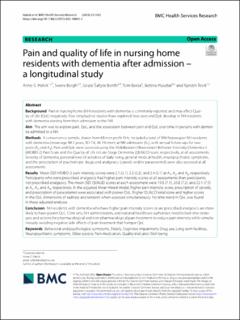| dc.contributor.author | Helvik, Anne-Sofie | |
| dc.contributor.author | Bergh, Sverre | |
| dc.contributor.author | Saltyte Benth, Jurate | |
| dc.contributor.author | Borza, Tom | |
| dc.contributor.author | Husebø, Bettina Elisabeth Franziska | |
| dc.contributor.author | Tevik, Kjerstin Elisabeth | |
| dc.date.accessioned | 2023-10-11T13:01:52Z | |
| dc.date.available | 2023-10-11T13:01:52Z | |
| dc.date.created | 2023-10-03T10:56:34Z | |
| dc.date.issued | 2023 | |
| dc.identifier.citation | BMC Health Serv Res . 2023 Sep 27;23(1):1032. | en_US |
| dc.identifier.issn | 1472-6963 | |
| dc.identifier.uri | https://hdl.handle.net/11250/3095834 | |
| dc.description.abstract | Pain in nursing home (NH) residents with dementia is commonly reported and may affect Quality of Life (QoL) negatively. Few longitudinal studies have explored how pain and QoL develop in NH residents with dementia starting from their admission to the NH. Aim The aim was to explore pain, QoL, and the association between pain and QoL over time in persons with dementia admitted to a NH. Methods A convenience sample, drawn from 68 non-profit NHs, included a total of 996 Norwegian NH residents with dementia (mean age 84.5 years, SD 7.6, 36.1% men) at NH admission (A1), with annual follow-ups for two years (A2 and A3). Pain and QoL were assessed using the Mobilization-Observation-Behavior-Intensity-Dementia-2 (MOBID-2) Pain Scale and the Quality of Life in Late-Stage Dementia (QUALID) scale, respectively, at all assessments. Severity of dementia, personal level of activities of daily living, general medical health, neuropsychiatric symptoms, and the prescription of psychotropic drugs and analgesics (opioids and/or paracetamol) were also assessed at all assessments. Results Mean (SD) MOBID-2 pain intensity scores were 2.1 (2.1), 2.2 (2.2), and 2.4 (2.1) at A1, A2, and A3, respectively. Participants who were prescribed analgesics had higher pain intensity scores at all assessments than participants not prescribed analgesics. The mean (SD) QUALID scores at each assessment were 19.8 (7.1), 20.8 (7.2), and 22.1 (7.5) at A1, A2, and A3, respectively. In the adjusted linear mixed model, higher pain intensity score, prescription of opioids, and prescription of paracetamol were associated with poorer QoL (higher QUALID total score and higher scores in the QoL dimensions of sadness and tension) when assessed simultaneously. No time trend in QoL was found in these adjusted analyses. Conclusion NH residents with dementia who have higher pain intensity scores or are prescribed analgesics are more likely to have poorer QoL. Clinicians, NH administrators, and national healthcare authorities need to look into strategies and actions for pharmacological and non-pharmacological pain treatment to reduce pain intensity while simultaneously avoiding negative side effects of pain treatment that hamper QoL. Peer Review reports | en_US |
| dc.description.sponsorship | Open access funding provided by Norwegian University of Science and Technology The study was initiated, administered, and funded by the Public Hospital Research Centre for Age-Related Functional Decline and Disease, Innlandet Hospital Trust, Norway. The Research Centre is publically funded and does not rely on funding from industry or commercial interests. The Research Centre took part in the study design, the data collection in municipality nursing homes, and the preparation of the manuscript. | en_US |
| dc.language.iso | eng | en_US |
| dc.publisher | BMC | en_US |
| dc.rights | Navngivelse-Ikkekommersiell 4.0 Internasjonal | * |
| dc.rights.uri | http://creativecommons.org/licenses/by-nc/4.0/deed.no | * |
| dc.subject | Behavioral and psychological symptoms; | en_US |
| dc.subject | Cognitive impairment; | en_US |
| dc.subject | Drug use; | en_US |
| dc.subject | Elderly; | en_US |
| dc.subject | Long term facilities; | en_US |
| dc.subject | Neuropsychiatric symptoms; | en_US |
| dc.subject | Older people; | en_US |
| dc.subject | Pain medication; | en_US |
| dc.subject | Quality indicator; | en_US |
| dc.subject | Well-being. | en_US |
| dc.title | Pain and quality of life in nursing home residents with dementia after admission – a longitudinal study | en_US |
| dc.type | Peer reviewed | en_US |
| dc.type | Journal article | en_US |
| dc.description.version | publishedVersion | en_US |
| dc.rights.holder | © The Author(s) 2023. Open Access This article is licensed under a Creative Commons Attribution 4.0 International License, which permits use, sharing, adaptation, distribution and reproduction in any medium or format, as long as you give appropriate credit to the original author(s) and the source, provide a link to the Creative Commons licence, and indicate if changes were made. The images or other third party material in this article are included in the article’s Creative Commons licence, unless indicated otherwise in a credit line to the material. If material is not included in the article’s Creative Commons licence and your intended use is not permitted by statutory regulation or exceeds the permitted use, you will need to obtain permission directly from the copyright holder. To view a copy of this licence, visit http://creativecommons.org/licenses/by/4.0/. The Creative Commons Public Domain Dedication waiver (http://creativecom‑ mons.org/publicdomain/zero/1.0/) applies to the data made available in this article, unless otherwise stated in a credit line to the data. | en_US |
| dc.source.volume | 23 | en_US |
| dc.source.journal | BMC Health Services Research | en_US |
| dc.source.issue | 1 | en_US |
| dc.identifier.doi | 10.1186/s12913-023-10041-5 | |
| dc.identifier.cristin | 2181244 | |
| dc.relation.project | [Norwegian Regional Ethics Committee South East]: [2014/917] | en_US |
| dc.source.articlenumber | 1032 | en_US |
| cristin.ispublished | true | |
| cristin.fulltext | original | |
| cristin.qualitycode | 2 | |

